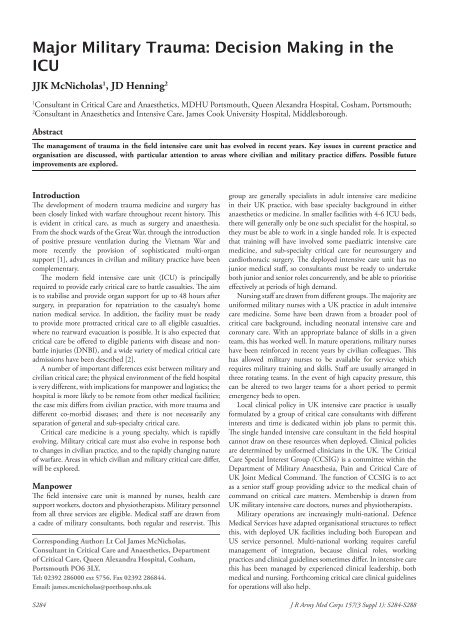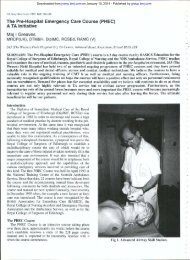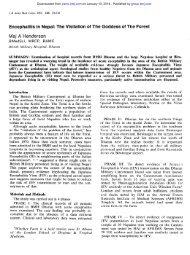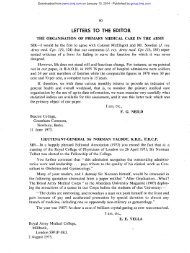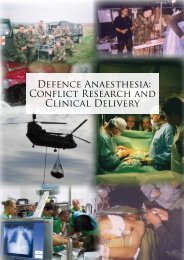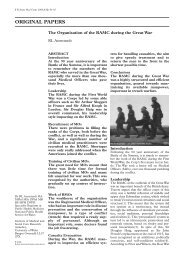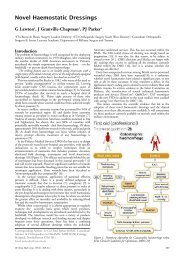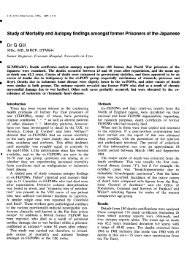JJK McNicholas, JD Henning. Major Military Trauma: Decision ...
JJK McNicholas, JD Henning. Major Military Trauma: Decision ...
JJK McNicholas, JD Henning. Major Military Trauma: Decision ...
You also want an ePaper? Increase the reach of your titles
YUMPU automatically turns print PDFs into web optimized ePapers that Google loves.
<strong>Major</strong> <strong>Military</strong> <strong>Trauma</strong>: <strong>Decision</strong> Making in the<br />
ICU<br />
<strong>JJK</strong> <strong>McNicholas</strong> 1 , <strong>JD</strong> <strong>Henning</strong> 2<br />
1 Consultant in Critical Care and Anaesthetics, MDHU Portsmouth, Queen Alexandra Hospital, Cosham, Portsmouth;<br />
2 Consultant in Anaesthetics and Intensive Care, James Cook University Hospital, Middlesborough.<br />
Abstract<br />
The management of trauma in the field intensive care unit has evolved in recent years. Key issues in current practice and<br />
organisation are discussed, with particular attention to areas where civilian and military practice differs. Possible future<br />
improvements are explored.<br />
Introduction<br />
The development of modern trauma medicine and surgery has<br />
been closely linked with warfare throughout recent history. This<br />
is evident in critical care, as much as surgery and anaesthesia.<br />
From the shock wards of the Great War, through the introduction<br />
of positive pressure ventilation during the Vietnam War and<br />
more recently the provision of sophisticated multi-organ<br />
support [1], advances in civilian and military practice have been<br />
complementary.<br />
The modern field intensive care unit (ICU) is principally<br />
required to provide early critical care to battle casualties. The aim<br />
is to stabilise and provide organ support for up to 48 hours after<br />
surgery, in preparation for repatriation to the casualty’s home<br />
nation medical service. In addition, the facility must be ready<br />
to provide more protracted critical care to all eligible casualties,<br />
where no rearward evacuation is possible. It is also expected that<br />
critical care be offered to eligible patients with disease and nonbattle<br />
injuries (DNBI), and a wide variety of medical critical care<br />
admissions have been described [2].<br />
A number of important differences exist between military and<br />
civilian critical care; the physical environment of the field hospital<br />
is very different, with implications for manpower and logistics; the<br />
hospital is more likely to be remote from other medical facilities;<br />
the case mix differs from civilian practice, with more trauma and<br />
different co-morbid diseases; and there is not necessarily any<br />
separation of general and sub-specialty critical care.<br />
Critical care medicine is a young specialty, which is rapidly<br />
evolving. <strong>Military</strong> critical care must also evolve in response both<br />
to changes in civilian practice, and to the rapidly changing nature<br />
of warfare. Areas in which civilian and military critical care differ,<br />
will be explored.<br />
Manpower<br />
The field intensive care unit is manned by nurses, health care<br />
support workers, doctors and physiotherapists. <strong>Military</strong> personnel<br />
from all three services are eligible. Medical staff are drawn from<br />
a cadre of military consultants, both regular and reservist. This<br />
Corresponding Author: Lt Col James <strong>McNicholas</strong>,<br />
Consultant in Critical Care and Anaesthetics, Department<br />
of Critical Care, Queen Alexandra Hospital, Cosham,<br />
Portsmouth PO6 3LY.<br />
Tel: 02392 286000 ext 5756. Fax 02392 286844.<br />
Email: james.mcnicholas@porthosp.nhs.uk<br />
group are generally specialists in adult intensive care medicine<br />
in their UK practice, with base specialty background in either<br />
anaesthetics or medicine. In smaller facilities with 4-6 ICU beds,<br />
there will generally only be one such specialist for the hospital, so<br />
they must be able to work in a single handed role. It is expected<br />
that training will have involved some paediatric intensive care<br />
medicine, and sub-specialty critical care for neurosurgery and<br />
cardiothoracic surgery. The deployed intensive care unit has no<br />
junior medical staff, so consultants must be ready to undertake<br />
both junior and senior roles concurrently, and be able to prioritise<br />
effectively at periods of high demand.<br />
Nursing staff are drawn from different groups. The majority are<br />
uniformed military nurses with a UK practice in adult intensive<br />
care medicine. Some have been drawn from a broader pool of<br />
critical care background, including neonatal intensive care and<br />
coronary care. With an appropriate balance of skills in a given<br />
team, this has worked well. In mature operations, military nurses<br />
have been reinforced in recent years by civilian colleagues. This<br />
has allowed military nurses to be available for service which<br />
requires military training and skills. Staff are usually arranged in<br />
three rotating teams. In the event of high capacity pressure, this<br />
can be altered to two larger teams for a short period to permit<br />
emergency beds to open.<br />
Local clinical policy in UK intensive care practice is usually<br />
formulated by a group of critical care consultants with different<br />
interests and time is dedicated within job plans to permit this.<br />
The single handed intensive care consultant in the field hospital<br />
cannot draw on these resources when deployed. Clinical policies<br />
are determined by uniformed clinicians in the UK. The Critical<br />
Care Special Interest Group (CCSIG) is a committee within the<br />
Department of <strong>Military</strong> Anaesthesia, Pain and Critical Care of<br />
UK Joint Medical Command. The function of CCSIG is to act<br />
as a senior staff group providing advice to the medical chain of<br />
command on critical care matters. Membership is drawn from<br />
UK military intensive care doctors, nurses and physiotherapists.<br />
<strong>Military</strong> operations are increasingly multi-national. Defence<br />
Medical Services have adapted organisational structures to reflect<br />
this, with deployed UK facilities including both European and<br />
US service personnel. Multi-national working requires careful<br />
management of integration, because clinical roles, working<br />
practices and clinical guidelines sometimes differ. In intensive care<br />
this has been managed by experienced clinical leadership, both<br />
medical and nursing. Forthcoming critical care clinical guidelines<br />
for operations will also help.<br />
S284 J R Army Med Corps 157(3 Suppl 1): S284-S288
Intensive Care <strong>Decision</strong>s <strong>JJK</strong> <strong>McNicholas</strong>, <strong>JD</strong> <strong>Henning</strong><br />
Logistics<br />
Despite improved logistics in recent years, the isolated nature<br />
of the hospital means that the ICU needs to be able to support<br />
itself as much as possible. It may not be possible to mount<br />
a substantial resupply chain in the early phases of an entry<br />
operation and even on mature campaigns the air bridge may be<br />
interrupted at intervals. Equipment must therefore have certain<br />
specific attributes to ensure it will meet the requirements of the<br />
operational environment (Box 1). The potential conflict between<br />
these constraints means that risk assessment will also need to be<br />
robust. Examples of items which increase self sufficiency include<br />
electrical items which can accept multiple power inputs should<br />
generators fail, and ventilators which accept oxygen from low<br />
pressure oxygen concentrators to minimise the use of cylinders.<br />
The possibility of a surge requirement means that there must also<br />
be redundancy in the unit equipment scale.<br />
Robust<br />
Dependable at extremes of temperature<br />
Able to provide therapy to the best practice standard<br />
Substantial battery backup<br />
Physically small<br />
Tactically packed<br />
Intuitive to use<br />
Box 1 Generic attributes of deployed intensive care equipment<br />
As in civilian practice there is a requirement for a temperature<br />
controlled logistic chain. If this should fail some drugs will lose<br />
efficacy, and some become dangerous. A thorough knowledge of<br />
how temperature can affect drugs is required.<br />
Finally, it should be noted that personnel are in short supply<br />
in the field environment, so all staff need to be able to carry out<br />
user equipment checks and repairs, as well as having a good<br />
understanding of resupply.<br />
Admission and Discharge<br />
The Intensive Care is described as ‘the degree of care of care,<br />
which is extensive, highly technical and required because of the<br />
patient’s actual or threatened inability to maintain function’ [3]. In<br />
principle therefore, any patient who is too sick to be cared for on<br />
an intermediate care bed, should be looked after in ICU until<br />
they are well enough to be discharged, or transferred to another<br />
Medical Treatment Facility (MTF). Operational ICUs however<br />
have limited capacity, and can only remain open to admissions<br />
by evacuating their patients early, preferably within 48 hours.<br />
Many admissions are therefore of short duration. The ethics of<br />
this are discussed elsewhere in this article, but the mechanics are<br />
also important.<br />
For the severely sick patient, the field ICU phase is often the first<br />
occasion that there is time to review thoroughly what has happened.<br />
A total review of the notes must be made and a tertiary survey<br />
undertaken, with careful documentation of all injuries. There is<br />
evidence from civilian literature that 40% of minor orthopaedic<br />
injuries are missed in the emergency department (ED) [4].<br />
Equally important is the preparation for discharge of the<br />
ICU patient; by the time a patient gets to the home nation<br />
ICU, they may have had nine handovers of care (Box 2). Robust<br />
documentation is essential as is a contemporaneous copy of the<br />
observations, because what may seem unimportant in the acute<br />
event maybe of note later.<br />
Buddy Aid to Team Medic<br />
Team Medic to BATLS Medic<br />
BATLS Medic to Role 1 Doctor<br />
Role 1 to MERT<br />
MERT to ED<br />
ED to Theatre<br />
Theatre to ICU<br />
ICU to CCAST<br />
CCAST to home nation ICU<br />
Box 2 Sequential handovers in the route to home nation ICU. BATLS<br />
– Battlefield Advanced Life Support; MERT – Medical Emergency<br />
Response Team; ED – Emergency Department; ICU – Intensive Care<br />
Unit; CCAST – Critical Care Air Support Team<br />
Organ Support<br />
The essential role of an ICU (on operations or not) is to support<br />
failing organ systems in the critically sick patient. A broad range<br />
of organ support is offered, commensurate with the requirements<br />
of the particular case mix.<br />
Respiratory Support<br />
The ideal field ventilator should be able to support any manner of<br />
lung injury. The recently introduced Vela Ventilator [5] provides<br />
all modern modes of conventional invasive ventilation and permits<br />
non-invasive ventilation. It represents a significant improvement<br />
in the available range of respiratory support. This is timely<br />
because soldiers are now surviving ever more profound injuries,<br />
and the boundaries of conventional ventilation are being tested.<br />
Severe blast lung responds well to high positive end expiratory<br />
pressure (PEEP), but this can impair venous return, leading to<br />
hypotension. This is more marked where there is concomitant<br />
hypovolaemia, but also occurs in the volume-replete casualty.<br />
Marked bronchopleural leaks can require asymmetric ventilation<br />
with two ventilators via a double lumen endotracheal tube.<br />
This strategy has also been used recently by one of the authors<br />
for a devastating unilateral blast lung injury without thoracic<br />
penetration, and led to a significant improvement in oxygenation.<br />
Cardiovascular Support<br />
Cardiovascular support in the multiply injured military patient<br />
differs from usual civilian practice. The trained soldier maintains<br />
a very high level of physical fitness and resting cardiovascular<br />
parameters will not be normal. Resting blood pressure and heart<br />
rate are likely to be lower than the civilian population and skeletal<br />
muscle mass may be greater. Vasoactive drugs are not frequently<br />
used in the early phase and indeed may be detrimental [6], as oxygen<br />
delivery and organ perfusion can usually be maintained with<br />
volume resuscitation. Subsequently, in some but not all casualties,<br />
there may be a phase of profound inflammatory response, with<br />
vasodilatation secondary to release of cytokines. This group may<br />
develop a vasoactive drug requirement. Complicating this may be<br />
the effect of blast on the heart, which is poorly understood. There<br />
is a clear need to understand the mechanics of the circulatory<br />
system in this group of patients, and to define resuscitation end<br />
points which confer outcome benefit.<br />
Gastrointestinal Support<br />
Early enteral feeding of critically ill patients has been shown to<br />
decrease the incidence of ventilator acquired pneumonia, and<br />
possibly decrease length of stay (LOS) on ICU [7]. However, many<br />
J R Army Med Corps 157(3 Suppl 1): S284-S288 S285
Intensive Care <strong>Decision</strong>s<br />
of the patients admitted to field ICUs will be transported by air<br />
within 48 hours of admission. It is possible that the accelerations<br />
and pressure changes of air transport may predispose to aspiration<br />
if the stomach is full. Early feeding may therefore be detrimental,<br />
if transport is imminent. This is the subject of current research.<br />
<strong>Trauma</strong> patients also have a high metabolic load, and may need<br />
a higher calorie intake than other ICU patients for the benefits of<br />
decreased LOS and morbidity to occur. Delayed feeding may lead<br />
to a marked calorie deficit early in their stay, which may never be<br />
made up [8].<br />
It is also established that this group of patients has a high<br />
incidence of Abdominal Compartment Syndrome. This can impair<br />
ventilation and renal function and potentially cause circulatory<br />
collapse. It is therefore essential that abdominal pressure is<br />
measured routinely. In order to avoid this complication, delayed<br />
primary closure for abdominal wounds is now well accepted.<br />
Renal Support<br />
Renal support in ICU is traditionally with Continuous Venovenous<br />
Haemofiltration (CVVHF), but this is usually not available in the<br />
field hospital as it is resource intensive (CVVHF may use 60 litres<br />
of fluid per day) and may increase ICU length of stay [9]. Some<br />
authors have advocated the use of peritoneal dialysis instead of<br />
CVVHF, or a furosemide diuresis to permit regulation of fluid<br />
balance. This does not however answer the problem of increased<br />
ICU stay. It is the authors’ view, that if renal replacement therapy<br />
is to be attempted in the field hospital, then CVVHF should be<br />
provided, if not the patient should be evacuated. The RAF Critical<br />
Care Air Support Teams (CCAST) maintain CVVHF capability.<br />
This is used in the field hospital prior to transport, for the casualty<br />
in whom delay would be detrimental.<br />
Sedation and Analgesia<br />
A full range of sedative and analgesic medications are available,<br />
and the principle of balanced analgesia is used. All patients with<br />
painful conditions receive regular paracetamol and consideration<br />
of a non-steroidal anti-inflammatory. For ventilated casualties,<br />
where emergence is considered likely within 48 hours, the choice<br />
of propofol for sedation and alfentanil for analgesia is usual.<br />
Where emergence is likely to be more protracted midazolam may<br />
be chosen for sedation and morphine for analgesia. Tramadol and<br />
clonidine are available as adjuncts. Amitriptyline is routinely given<br />
to limb amputees, with the intention of preventing neuropathic<br />
pain, notwithstanding the fact that preventive benefit remains<br />
unproven [10].<br />
Local anaesthetic techniques are popular, particularly for<br />
amputees and abdominal injuries. Neuraxial blocks and peripheral<br />
nerve blocks, both with indwelling catheters, are now regularly<br />
used and ultrasound guidance is available to assist placement of<br />
peripheral blocks. Whilst these techniques can be very effective,<br />
caution must be exercised to ensure that there is no coagulopathy<br />
where neuraxial block is considered, and that the skin surface is<br />
not contaminated by debris from the initial injury. In the event of<br />
an epidural haematoma, diagnosis would be difficult as MRI is not<br />
available. Local anaesthetic infusions, usually 0.2% ropivacaine,<br />
are delivered from either syringe drivers or elastomeric pumps.<br />
Epidural and peripheral nerve catheters are clearly labelled as such<br />
and extension tubing includes a high visibility yellow stripe for<br />
easy identification.<br />
Sedation scoring is undertaken every hour for every patient,<br />
with appropriate titration of sedative medication. Unless<br />
S286<br />
<strong>JJK</strong> <strong>McNicholas</strong>, <strong>JD</strong> <strong>Henning</strong><br />
specifically contra-indicated a lightly sedated state is sought. A<br />
daily sedation hold is routine and the consultant should indicate<br />
exceptions to this practice, rather than requesting it.<br />
Coagulopathy<br />
The Acute Coagulopathy of <strong>Trauma</strong> Syndrome (ACoTS) is<br />
achieving wider recognition as the explanation of coagulopathy<br />
in trauma [11]. It is complex and differs from conventional<br />
explanations of trauma coagulopathy. A better understanding<br />
of trauma coagulopathy has led to an aggressive approach to<br />
correction during the phase of resuscitation and surgery. Empirical<br />
transfusion of a higher ratio of fresh frozen plasma to packed<br />
red blood cells, usually a 1:1 ratio, in the context of massive<br />
transfusion, is now recognised as best practice in military units.<br />
This has almost certainly saved lives, and is felt to have prevented<br />
many ICU admissions.<br />
The more normal response to trauma is a hypercoagulable state.<br />
Even those with impaired coagulation on admission to hospital<br />
may swiftly become prone to thrombosis, certainly within 48<br />
hours [12], and particularly where older blood products are<br />
given or recombinant factor VII has been used [13]. This field<br />
is developing rapidly and further research is needed to quantify<br />
the risks.<br />
One practical difficulty in the field ICU environment is when<br />
to make the decision to stop aggressive blood product transfusion<br />
with the 1:1 ratio of fresh frozen plasma and packed red blood cells<br />
and revert to a conventional transfusion approach. This decision<br />
may be assisted by point of care testing - haemoglobin is measured<br />
using i-Stat ® and clotting using ROTEM ® - with conventional<br />
transfusion being adopted as ROTEM ® normalises. In essence<br />
however the decision remains one of clinical judgement. A further<br />
difficulty is when to start chemical thromboprophylaxis; trauma<br />
patients have a 10-fold increase in the incidence of thrombotic<br />
events, therefore active prophylaxis should be started as soon as<br />
possible and certainly as soon as the ROTEM ® starts to return to<br />
normal [14].<br />
There is also now a group of patients, who may need ongoing<br />
resuscitation, continued during CCAST evacuation. Examples<br />
include those with multiple fasciotomies or devastating pelvic soft<br />
tissue injuries.<br />
Preparation for Evacuation<br />
The concept of field intensive care medicine depends upon<br />
aggressive early stabilisation after surgery and early rearward<br />
evacuation. Early evacuation is important for two reasons; the<br />
facility must be able to accommodate a high volume of admissions,<br />
with a relatively small capacity; complex and protracted critical<br />
care, where this is required, is better managed in a UK facility<br />
with access to the full range of clinical resources.<br />
Among the most difficult decisions is when to effect evacuation<br />
in the unstable patient. There is a balance of risks. To retain the<br />
patient in the field ICU, permits surgical intervention, maintains<br />
access to laboratory and imaging resources and delays the effects<br />
of transport. To transfer allows earlier access to the full range of<br />
clinical resources in the UK (or other home nation).<br />
There are no definitive criteria upon which to base a decision<br />
and the judgement of experienced clinicians is required. If life<br />
or limb saving surgical intervention is judged to be likely before<br />
transfer can be completed, then the patient should be retained. If<br />
it is judged that there are critical care interventions, which can be<br />
accomplished prior to transport, which cannot be undertaken in<br />
J R Army Med Corps 157(3 Suppl 1): S284-S288
Intensive Care <strong>Decision</strong>s <strong>JJK</strong> <strong>McNicholas</strong>, <strong>JD</strong> <strong>Henning</strong><br />
flight by the CCAST, and which will permit safer transport, then<br />
the patient should be retained.<br />
Future Developments<br />
The resuscitation of military polytrauma has changed during the<br />
past decade, with the introduction of topical haemostatics and<br />
tourniquets, empirical transfusion of fresh frozen plasma and<br />
platelets, and the description of damage control resuscitation<br />
[15]. This is likely to continue, and there are several critical care<br />
therapies which may find a place.<br />
High Frequency Oscillatory Ventilation<br />
High Frequency Oscillatory Ventilation (HFOV) has been<br />
investigated for the treatment of Adult Respiratory Distress<br />
Symdrome (ARDS), with a large randomised controlled trial<br />
(RCT) showing early improvement in oxygenation but no overall<br />
mortality benefit [16]. Meta-analysis of six RCTs did show<br />
mortality benefit, and concluded that HFOV might improve<br />
survival [17], though the results must be treated with caution as<br />
not all controls received low tidal volume ventilation [18]. Best<br />
practice in ARDS now requires low tidal volume ventilation,<br />
so it remains unclear whether HFOV is likely to lead to better<br />
outcomes than low tidal volume conventional ventilation. The<br />
High Frequency Oscillation in ARDS (OSCAR) trial is currently<br />
investigating the use of oscillatory ventilation as an alternative<br />
to low tidal volume conventional ventilation in ARDS. <strong>Military</strong><br />
critical care admissions often suffer from ARDS either as a result<br />
of chest trauma, or secondary to the inflammatory process<br />
accompanying trauma elsewhere. If HFOV is shown to have<br />
outcome benefit in the civilian context, this may be transferable<br />
to the field environment.<br />
Extra-corporeal CO 2 Removal<br />
Extra-corporeal CO 2 removal ( ECCO 2 R) may be of advantage in<br />
patients who are difficult to ventilate with poor lung compliance.<br />
There are well developed technologies now available for extracorporeal<br />
CO 2 removal. The principle involves diversion of a<br />
proportion of cardiac output through an extra-corporeal filter,<br />
across which CO 2 is removed into a fresh gas supply. Cannulation<br />
of a femoral artery and vein are required and flow is generated by<br />
the patient’s arterial blood pressure. The main benefit is that tidal<br />
ventilation may be reduced to very low levels, whilst maintaining<br />
physiological pH. This has been called ultra-protective lung<br />
ventilation and seeks to avoid regional hyperinflation of the lung.<br />
There is evidence of regional lung hyperinflation, even with a low<br />
tidal volume ventilation strategy [19].<br />
ECCO 2 R has been used for transportation of severe ARDS<br />
and in trauma where ventilation is difficult [20, 21]. It has also<br />
been used for other causes of ventilatory failure or hypoxaemic<br />
respiratory failure in which permissive hypercapnoea is chosen<br />
[22, 23]. This technology is of limited benefit in providing<br />
oxygenation to the patient who is difficult to oxygenate. At present<br />
there are no established criteria upon which to select patients for<br />
ECCO 2 R, in the context of trauma.<br />
Introduction of ECCO 2 R into the field would be challenging.<br />
Both the CCAST and intensive care consultant cadres would need<br />
to be trained and experienced in its use, and cannula placement<br />
would need to be learned. Iatrogenic complications are described,<br />
such as haemorrhage, ischaemia and inadvertent displacement,<br />
and are difficult to quantify as the published series are small. Risks<br />
may be mitigated in the future; the cannulae now used are smaller<br />
than previously and the membrane technology has improved in<br />
recent years, permitting lower flow resistance and enabling devices<br />
to perform for protracted periods.<br />
Ethical Issues<br />
The principles of medical ethics must inform all medical<br />
practice; their application must evolve as medicine changes.<br />
Critical care medicine is a relatively new field and one in which<br />
rapid technological advance has greatly influenced treatment<br />
possibilities. Ethical dilemmas have arisen in the wake of these<br />
developments, which are unique to critical care practice. One<br />
example among many is the advent of brain stem death and the<br />
potential for organ donation in these circumstances, which is a<br />
direct consequence of the possibility of mechanical ventilation.<br />
<strong>Military</strong> critical care is also evolving swiftly and the clinical<br />
scenarios are unique to the environment. The juxtaposition of<br />
high technology critical care capability and a high volume of<br />
military penetrating trauma is found only in the military field<br />
hospital. It is not surprising therefore that clinical dilemmas arise,<br />
for which there is little precedent elsewhere.<br />
Among the particular areas, which require the clinician to<br />
give careful consideration to the principles of medical ethics are:<br />
prolonged critical care admission for local casualties in a facility<br />
originally intended for 48 hour holding; evolving boundaries of<br />
survivability in extreme polytrauma; resource allocation without<br />
the flexibility of a comprehensive local critical care system; the<br />
provision of a critical care service to different demographic<br />
groups, with different lines of evacuation and rehabilitation<br />
services; communication and the use of interpreters; paediatric<br />
critical care provided by predominantly adult specialists; creation<br />
of the expectation of critical care in the location, followed<br />
by inevitable withdrawal from the area in time; reluctance to<br />
undermine the development of local critical care capability;<br />
the decision to repatriate where death is expected; continuity<br />
of clinical practice in a remote environment with a rapidly<br />
changing staff.<br />
<strong>Decision</strong>s of this kind are difficult and likely to be unfamiliar<br />
to many clinicians. At present decision making is strengthened<br />
by several means: the deployed medical director is an experienced<br />
military clinician, who will have undertaken operational tours in<br />
recent years and will be involved in the most difficult decisions;<br />
all unfamiliar or difficult choices are made by more than one<br />
consultant; the pace of operations in recent years has meant that<br />
corporate expertise has accumulated within a relatively small<br />
cadre of providers.<br />
There is little clinical research, which specifically investigates<br />
the ethics of military critical care. <strong>Military</strong> medical support to<br />
civilians on operations was investigated recently, using Delphi<br />
methodology [24]. This approach may provide a means by<br />
which a more secure evidence base can be developed to assist the<br />
deployed clinician.<br />
References<br />
1. <strong>Henning</strong> <strong>JD</strong>, Roberts MJ, Sharma D et al. <strong>Military</strong> Intensive Care<br />
Part 1. A Historical Review. J R Army Med Corps 2007; 153(4):<br />
283-285.<br />
2. Porter D, Johnston AMcD, <strong>Henning</strong> <strong>JD</strong>. Medical Conditions<br />
requiring Intensive Care. J R Army Med Corps 2009; 155(2): 141-<br />
146.<br />
3. AMedP-13 NATO Glossary of Medical Terms and Definitions<br />
Nov 2000.<br />
J R Army Med Corps 157(3 Suppl 1): S284-S288 S287
Intensive Care <strong>Decision</strong>s<br />
4. Thomson CB, Greaves I. Missed Injury and the tertiary trauma<br />
survey. Injury. 2008; 39(1): 107-14.<br />
5. Vela Ventilator Systems Operator’s manual. Care Fusion. California<br />
2010.<br />
6. Collier B, Dossett L, Mann M, Cotton B et al. Vasopressin use is<br />
associated with death in acute trauma patients with shock. J Crit<br />
Care 2010; 25(1): 173. e9-14.<br />
7. Artinian V, Krayem H and DiGiovine B. Effects of early enteral<br />
feeing on the outcome of critically ill mechanically ventilated<br />
medical patients. Chest 2006; 129(4): 960-7.<br />
8. Jacobs DG, Jacobs DO, Kudsk KA. Practice management<br />
guidelines for nutritional support of the trauma patient. J <strong>Trauma</strong><br />
2004; 57: 660-78.<br />
9. Elseviers MM, Lins RL, Van der Niepen P et al. Renal Replacement<br />
is an independent risk factor for mortality in critically ill patients<br />
with acute kidney injury. Crit Care 2010 Dec 1;14(6): R221 {epub<br />
ahead of print} .<br />
10. Saarto T, Wiffen PJ. Antidepressants for neuropathic pain. Cochrane<br />
Database Syst Rev 2007; 17(4): CD005454.<br />
11. Brohi K. <strong>Trauma</strong> Induced Coagulopathy. J R Army Med Corps<br />
2009; 155(4): 320-2.<br />
12. Selby R, Geerts W, Ofosu FA et al. Hypercoagulability after trauma:<br />
Hemostatic changes and relationship to venous thromboembolism.<br />
Thromb Res 2009; 124(3): 281-7.<br />
13. Spinella PC, Carroll CL, Staff I et al. Duration of red blood<br />
cell storage is associated with increased incidence of deep vein<br />
thrombosis and in hospital mortality in patients with traumatic<br />
injuries. Crit Care 2009; 13(5): R151.<br />
14. Clinical Guidelines for Operations 2010. DCDC. London.<br />
15. Hodgetts TJ, Mahoney PF, Kirkmann E. Damage Control<br />
Resuscitation. J R Army Med Corps 2007; 153(4): 299-30.<br />
16. Derdak S, Mehta S, Stewart TE et al. High-frequency oscillatory<br />
ventilation for acute respiratory distress syndrome in adults: a<br />
randomised, controlled trial. Am J Respir Crit Care Med 2002;<br />
166(6): 801-8.<br />
S288<br />
<strong>JJK</strong> <strong>McNicholas</strong>, <strong>JD</strong> <strong>Henning</strong><br />
17. Sud S, Sud M, Friedrich JO et al. High frequency oscillation in<br />
patients with acute lung injury and acute respiratory distress<br />
syndrome (ARDS): a systematic review and meta-analysis. BMJ<br />
2010; 340: c2327.<br />
18. Fan E, Rubenfeld GD. High frequency oscillation in acute lung<br />
injury and ARDS. Definitive evidence about efficacy and quality of<br />
life is awaited. BMJ 2010; 340: c2315.<br />
19. Terragni PP, Rosboch G, Tealdi A et al. Tidal hyperinflation during<br />
low tidal volume ventilation in acute respiratory distress syndrome.<br />
Am J Respir Crit Care Med 2007; 175: 160-166.<br />
20. Zimmermann M, Philipp A, Schmid FX et al. From Baghdad to<br />
Germany: use of a new pumpless extracorporeal lung assist system<br />
in two severely injured US soldiers. ASAIO Journal 2007; 53: e4e6.<br />
21. McKinley J, Chapman G, Elliot S, Mallick A. Pre-emptive<br />
Novalung-assisted carbon dioxide removal in a patient with chest,<br />
head and abdominal injury. Anaesthesia 2008; 63: 767-770.<br />
22. Conrad SA, Zwischenberger JB, Grier LR et al. Total extracorporeal<br />
arteriovenous carbon dioxide removal in acute respiratory failure:<br />
a phase I clinical study. Intensive Care Med 2001; 27(8): 1340-51.<br />
23. Conrad SA, Green R, Scott LK. Near-fatal pediatric asthma<br />
managed with pumpless arteriovenous carbon dioxide removal.<br />
Crit Care Med 2007; 35(11): 2624-9.<br />
24. Hodgetts TJ, Mozumder A, Mahoney PF, McLennan J. Defence<br />
Medical Services Support to Civilians on Operations: Report of<br />
an Evidence Based Review. Academic Department of <strong>Military</strong><br />
Emergency Medicine, Royal Centre for Defence Medicine,<br />
Birmingham, 2005.<br />
Lessons Learned . . . . on Operation TELIC (Iraq) in 2003 about Surgery at Role 2<br />
Limb and abdominal surgery cannot be truly sorted unless there is an accurate and timely plan for casevac (the ‘back door’) at<br />
all times. This means having tactical awareness before, during and after surgery. Too much surgery was done at Role (R)2 - but<br />
such units were often unsure when they would be able to casevac their patients. There needed to be a more robust and close<br />
liaison between surgical and casevac assets. Half of helicopter casevac requests in forward units were not fulfilled. Critical Care<br />
Air Support Team assets should be embedded into all forward units as well as R3. Several Role 2 Field Surgical Teams (FSTs) were<br />
not closed down when R3 facilities were available close by, in some cases leading to forward casevac from R2 FST to R3. This<br />
led to inappropriate and potentially detrimental patient care, in that once the patient was in a ‘surgical facility’ , they were then<br />
a lower priority for onward movement. R3 units became R4 units when the rearward evacuation of Prisoners of War (POWs)<br />
became impossible for political reasons. Traction beams had to be fashioned from wooden pallets and POW long bone (femur,<br />
tibia) fractures treated to union over many weeks. No provision was made initially for the care of local people especially pregnant<br />
women and children. Anaesthetists often had to fashion ad-hoc paediatric anaesthetic equipment. Planning staffs should clearly<br />
have foreseen this POW and refugee problem.<br />
Parker PJ, Adams SA, Williams D, Shepherd A. Forward surgery on Operation Telic – Iraq 2003. J R Army Med Corps 2005;<br />
151(3): 186-91<br />
J R Army Med Corps 157(3 Suppl 1): S284-S288


